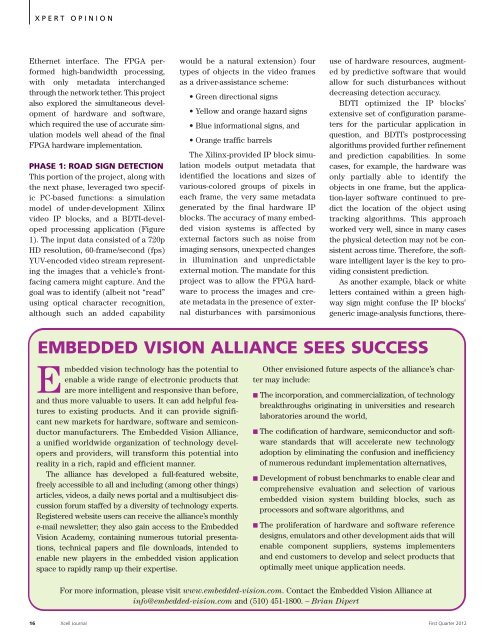Xcell Journal Issue 78: Charge to Market with Xilinx 7 Series ...
Xcell Journal Issue 78: Charge to Market with Xilinx 7 Series ...
Xcell Journal Issue 78: Charge to Market with Xilinx 7 Series ...
You also want an ePaper? Increase the reach of your titles
YUMPU automatically turns print PDFs into web optimized ePapers that Google loves.
XPERT OPINION<br />
Ethernet interface. The FPGA performed<br />
high-bandwidth processing,<br />
<strong>with</strong> only metadata interchanged<br />
through the network tether. This project<br />
also explored the simultaneous development<br />
of hardware and software,<br />
which required the use of accurate simulation<br />
models well ahead of the final<br />
FPGA hardware implementation.<br />
PHASE 1: ROAD SIGN DETECTION<br />
This portion of the project, along <strong>with</strong><br />
the next phase, leveraged two specific<br />
PC-based functions: a simulation<br />
model of under-development <strong>Xilinx</strong><br />
video IP blocks, and a BDTI-developed<br />
processing application (Figure<br />
1). The input data consisted of a 720p<br />
HD resolution, 60-frame/second (fps)<br />
YUV-encoded video stream representing<br />
the images that a vehicle’s frontfacing<br />
camera might capture. And the<br />
goal was <strong>to</strong> identify (albeit not “read”<br />
using optical character recognition,<br />
although such an added capability<br />
would be a natural extension) four<br />
types of objects in the video frames<br />
as a driver-assistance scheme:<br />
• Green directional signs<br />
• Yellow and orange hazard signs<br />
• Blue informational signs, and<br />
• Orange traffic barrels<br />
The <strong>Xilinx</strong>-provided IP block simulation<br />
models output metadata that<br />
identified the locations and sizes of<br />
various-colored groups of pixels in<br />
each frame, the very same metadata<br />
generated by the final hardware IP<br />
blocks. The accuracy of many embedded<br />
vision systems is affected by<br />
external fac<strong>to</strong>rs such as noise from<br />
imaging sensors, unexpected changes<br />
in illumination and unpredictable<br />
external motion. The mandate for this<br />
project was <strong>to</strong> allow the FPGA hardware<br />
<strong>to</strong> process the images and create<br />
metadata in the presence of external<br />
disturbances <strong>with</strong> parsimonious<br />
use of hardware resources, augmented<br />
by predictive software that would<br />
allow for such disturbances <strong>with</strong>out<br />
decreasing detection accuracy.<br />
BDTI optimized the IP blocks’<br />
extensive set of configuration parameters<br />
for the particular application in<br />
question, and BDTI’s postprocessing<br />
algorithms provided further refinement<br />
and prediction capabilities. In some<br />
cases, for example, the hardware was<br />
only partially able <strong>to</strong> identify the<br />
objects in one frame, but the application-layer<br />
software continued <strong>to</strong> predict<br />
the location of the object using<br />
tracking algorithms. This approach<br />
worked very well, since in many cases<br />
the physical detection may not be consistent<br />
across time. Therefore, the software<br />
intelligent layer is the key <strong>to</strong> providing<br />
consistent prediction.<br />
As another example, black or white<br />
letters contained <strong>with</strong>in a green highway<br />
sign might confuse the IP blocks’<br />
generic image-analysis functions, there-<br />
EMBEDDED VISION ALLIANCE SEES SUCCESS<br />
Embedded vision technology has the potential <strong>to</strong><br />
enable a wide range of electronic products that<br />
are more intelligent and responsive than before,<br />
and thus more valuable <strong>to</strong> users. It can add helpful features<br />
<strong>to</strong> existing products. And it can provide significant<br />
new markets for hardware, software and semiconduc<strong>to</strong>r<br />
manufacturers. The Embedded Vision Alliance,<br />
a unified worldwide organization of technology developers<br />
and providers, will transform this potential in<strong>to</strong><br />
reality in a rich, rapid and efficient manner.<br />
The alliance has developed a full-featured website,<br />
freely accessible <strong>to</strong> all and including (among other things)<br />
articles, videos, a daily news portal and a multisubject discussion<br />
forum staffed by a diversity of technology experts.<br />
Registered website users can receive the alliance’s monthly<br />
e-mail newsletter; they also gain access <strong>to</strong> the Embedded<br />
Vision Academy, containing numerous tu<strong>to</strong>rial presentations,<br />
technical papers and file downloads, intended <strong>to</strong><br />
enable new players in the embedded vision application<br />
space <strong>to</strong> rapidly ramp up their expertise.<br />
Other envisioned future aspects of the alliance’s charter<br />
may include:<br />
■ The incorporation, and commercialization, of technology<br />
breakthroughs originating in universities and research<br />
labora<strong>to</strong>ries around the world,<br />
■ The codification of hardware, semiconduc<strong>to</strong>r and software<br />
standards that will accelerate new technology<br />
adoption by eliminating the confusion and inefficiency<br />
of numerous redundant implementation alternatives,<br />
■ Development of robust benchmarks <strong>to</strong> enable clear and<br />
comprehensive evaluation and selection of various<br />
embedded vision system building blocks, such as<br />
processors and software algorithms, and<br />
■ The proliferation of hardware and software reference<br />
designs, emula<strong>to</strong>rs and other development aids that will<br />
enable component suppliers, systems implementers<br />
and end cus<strong>to</strong>mers <strong>to</strong> develop and select products that<br />
optimally meet unique application needs.<br />
For more information, please visit www.embedded-vision.com. Contact the Embedded Vision Alliance at<br />
info@embedded-vision.com and (510) 451-1800. – Brian Dipert<br />
16 <strong>Xcell</strong> <strong>Journal</strong> First Quarter 2012

















